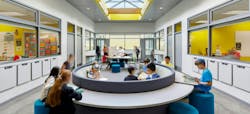Windows in K-12 classrooms provide opportunities, not distractions
On a knee-jerk level, a window seems like a built-in distraction, guaranteed to promote daydreaming and wandering minds in any classroom or workspace.
Yet, a steady stream of studies has found the opposite to be true. Instead of a distraction, the research connects transparency and views to improvements in cognitive function, productivity and attention span.
Discussions around window systems are particularly relevant on K-12 campuses, where some students have puppy-like attention spans. On top of design consideration issues, each school has its own security, transparency and pedagogical priorities, complicating the evaluation of any window strategy.
On several recent projects, LPA’s Sustainability & Applied Research team worked with designers and educators to dig deeper into the implications of different glazing choices on student outcomes. The research team explored available information to help school leaders choose windows systems that fit the needs of their students.
The Type of View Matters
A 2008 paper by University of Georgia professor C. Kenneth Tanner, "Effects of School Design on Student Outcomes," found five distinct view patterns in the school environment, each with its own implications.
- Views overlooking life. Students need vistas that are not a wall or parking lot.
- Unrestricted views. Windows, when possible, should be without obstructions such as posters and curtains.
- Living views. The ability to view indoor and outdoor spaces such as gardens, wildlife mountains, and the sky.
- Functional views. Students should be able to easily see at least 50 feet outside the classroom to rest their eyes.
- Green areas. Students should see outside spaces with trees, grass, or gardens.
K-12 Classrooms with Exterior Views
Research on learning spaces suggest that classrooms with a view positively impact student outcomes. 85% of educators say that views to nature are important for collaborative learning environments.
Increased attention span and enhanced cognitive functioning contribute to better performance across core disciplines and a more engaged classroom experience.
5 Factors Affecting Views
Beyond the basic benefits of windows, studies emphasize a myriad of factors that can affect the effectiveness of window systems:
- Glare
- Glazing
- View
- Size
- Orientation
Interior Views Are Complicated
The challenge of interior windows may be less about distraction and more about a culture of readiness to utilize nearby spaces. There are some emerging benefits of interior windows, such as encouraging choice and movement, engaging students with learning on display, and encouraging a sense of belonging.
A few cultural shifts are needed for greater adoption, however:
- Co-design fosters a culture of readiness for use of visible adjacent spaces.
- Interior views allow trust in students to use adjacent spaces responsibly with minimal supervision.
- Hampered permission can undermind student/teacher agency within the space.
